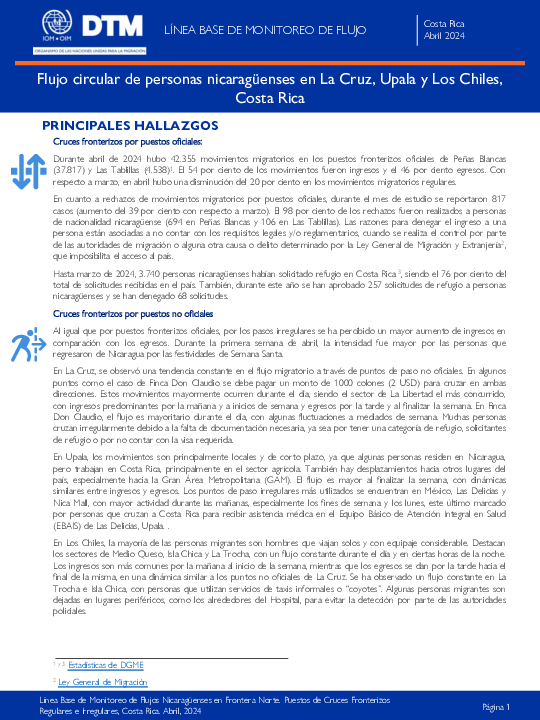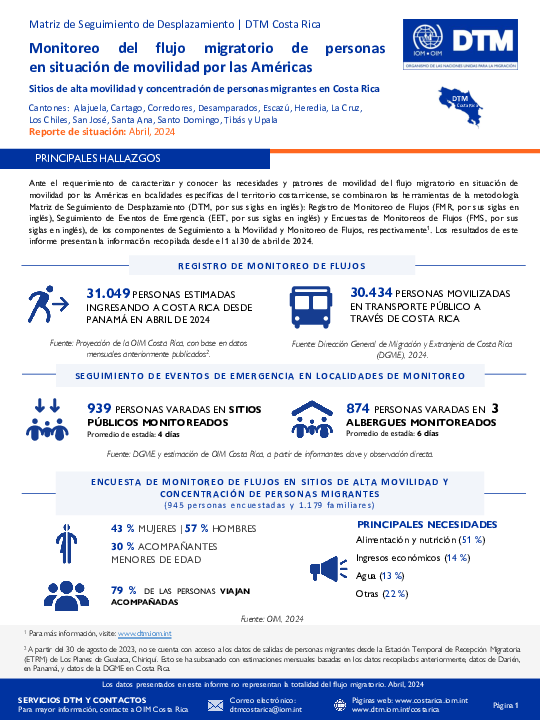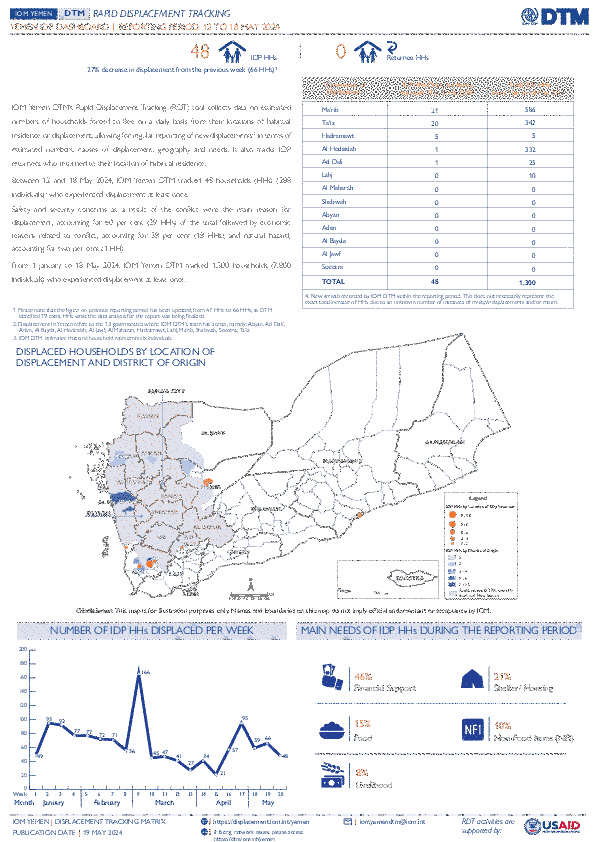-
Countries
-
Data and Analysis
-
Special Focus
-
Crisis Responses

Contact
DTMCostaRica@iom.int
Language
English
Location
Costa Rica
Period Covered
Apr 01 2024
Apr 30 2024
Activity
- Flow Monitoring
- Baseline Assessment
La Organización Internacional para las Migraciones (OIM), como agencia de las Naciones Unidas en materia de migración en Costa Rica, implementó, desde 2021, dos rondas de la Matriz de Seguimiento al Desplazamiento (DTM por sus siglas en inglés) como parte de su estrategia de monitoreo del flujo migratorio circular de personas de nacionalidad nicaragüense, en puntos fronterizos no oficiales, en distintos cantones del norte del país. A partir de este ejercicio en tres puntos de ingreso no oficial de la frontera con Nicaragua, se contabilizaron 60 697 movimientos migratorios, de los cuales el 59 por ciento fueron egresos y 41 por ciento ingresos.
Siendo parte fundamental de la misión de OIM brindar asesoría clave sobre políticas y prácticas migratorias, se vuelve necesario actualizar los datos de este flujo migratorio circular de nicaragüenses que cruzan tanto de forma regular como irregular la frontera norte de Costa Rica.
Según los registros de la DGME de ingresos y egresos regulares por puestos fronterizos oficiales en Los Chiles y Peñas Blancas, en 2022 hubo 394.730 movimientos migratorios regulares (50 % ingresos y 50 % egresos) mientras que, durante el 2023, en total se registraron 526.271 movimientos migratorios (50 % ingresos y 50 % egresos), lo cual representó un aumento de 33 por ciento con respecto a 2022. Durante abril de 2024, se realizaron un total de 42.355 movimientos migratorios siendo el 54 por ciento egresos y el 46 por ciento egresos.

Contact
DTMCostaRica@iom.int
Language
English
Location
Costa Rica
Period Covered
Apr 01 2024
Apr 30 2024
Activity
- Flow Monitoring
- Mobility Tracking
- Event Tracking
Cantons: Alajuela, Alajuelita, Cartago, Desamparados, Escazú, Corredores, Heredia, Los Chiles, San Carlos, San José, Santa Ana, Santo Domingo, Tibás
Costa Rica, like the other countries in the Central American region, has been characterized as a migratory corridor for people who transit by land from the south to the north of America and whose destination is the countries in the north of the continent. This flow on the move through the Americas is mainly made up of people from the Bolivarian Republic of Venezuela, Cuba, Haiti, Ecuador, as well as people from other countries in South America, Africa and Asia.
According to estimations from IOM Costa Rica, during April 31,049 people entered the country, an approximate average of 1,035 people per day and estimating a decrease of 14% compared to March 2024. In addition, 874 people stranded in the monitored shelters were identified and 939 people stranded in the public places visited.

Contact
DTM Ukraine, dtmukraine@iom.int
Language
English
Location
Ukraine
Period Covered
Feb 01 2024
Mar 31 2024
Activity
- Other
За два роки повномасштабного вторгнення гуманітарна ситуація в Україні, зокрема поблизу лінії фронту, дедалі ускладнюється. У зв’язку з цим Відділ даних та аналітики Міжнародної організації з міграції (МОМ) розробив систему моніторингу населення прифронтових територій для відстежування мобільності та критичних потреб цивільного населення в місцевостях, що суттєво постраждали від конфлікту. Ця система включає три ключові компоненти: Оцінку мобільності та потреб (MaNA), моніторинг населених пунктів на прифронтових територіях і моніторинг потоків у зонах евакуації. MaNA містить інформацію про оцінену чисельність населення з дезагрегацією за статтю та віком на рівні громад, а також про оцінену частку населення, що має гострі гуманітарні потреби. Моніторинг населених пунктів на прифронтових територіях надає змогу отримувати деталізовані базові розрахункові показники населення, а також інформацію про основні гуманітарні потреби у вибраних населених пунктах, розташованих у межах 25 км від лінії фронту, для ефективнішого розроблення сценаріїв та попереднього планування гуманітарної допомоги. Крім того, МОМ постійно відстежує динаміку переміщень, щоб надавати гуманітарним партнерам дані про напрями й масштаб переміщень із вибраних населених пунктів, де проходить евакуація. Кожен із цих компонентів спрямований на підтримку координації дієвого гуманітарного реагування, забезпечення безпеки та добробуту постраждалого населення прифронтових територій.

Contact
DTM Ukraine, dtmukraine@iom.int
Language
English
Location
Ukraine
Snapshot Date
Mar 19 2024
Activity
- Other
Ефективні ініціативи з відновлення та розвитку значною мірою спираються на дані, зібрані на місцевому рівні. Використання даних у плануванні та реалізації заходів з відновлення та розвитку гарантує, що ці процеси будуть підзвітними, фактологічно обґрунтованими та відображатимуть потреби громади.
Цей семінар мав на меті дослідити поточну та можливу роль даних у місцевих ініціативах з відновлення в Україні. Для цього в семінарі взяли участь представники Міністерства з питань відновлення, обласної та місцевої влади, донори, а також міжнародні та українські гуманітарні організації та організації, що займаються питаннями розвитку. Під час серії структурованих панельних дискусій учасники семінару розглянули потреби та виклики, з якими стикаються при створенні та використанні даних на місцевому рівні, щоб задовольнити вимоги відповідно до національної стратегії планування відновлення та залучити необхідну міжнародну допомогу.
У цьому звіті узагальнено обґрунтування та викладено основні моменти дискусій, які були зосереджені на очікуваних результатах семінару. Нарешті, на основі цих обговорень у звіті представлені деякі висновки та рекомендації, запропоновані учасниками.

Contact
Angélica Madrigal amadrigal@iom.int
Language
English
Location
Costa Rica
Period Covered
Apr 01 2024
Apr 30 2024
Activity
- Survey
- Registration
- Flow Monitoring
Cantones: Alajuela, Alajuelita, Cartago, Desamparados, Escazú, Corredores, Heredia, Los Chiles, San Carlos, San José, Santa Ana, Santo Domingo, Tibás
Costa Rica, al igual que los demás países de la región centroamericana, se ha caracterizado por ser un corredor migratorio para personas que transitan de manera terrestre desde el sur hasta el norte de América y que tienen como destino los países del norte del continente. Este flujo en situación de movilidad por las Américas se encuentra compuesto principalmente por personas de la República Bolivariana de Venezuela, Cuba, Haití, Ecuador, así como personas provenientes de otros países de Suramérica, África y Asia.
Según estimaciones de la OIM Costa Rica, durante abril ingresaron al país 31.049 personas, un promedio aproximado de 1.035 personas por día y estimando una disminución de un 14% con respecto a marzo de 2024. Además, se identificaron 874 personas varadas en los albergues monitoreados y 939 personas varadas en los sitios públicos visitados.
Contact
DTM Yemen, iomyemendtm@iom.int
Location
Yemen
Activity
- Mobility Tracking
- Event Tracking
Period Covered
May 12 2024 -May 18 2024
From 1 January to 18 May 2024, IOM Yemen DTM tracked 1,300 households (HH) (7,800 Individuals) who experienced displacement at least once .
Between 12 and 18 May 2024, IOM Yemen DTM tracked 48 households (288 individuals) displaced at least once. The majority of people moved into/within the following governorates and districts:
- Ma’rib (21 HHs) – Ma’rib City (15 HHs), Ma’rib (6 HHs) districts. Most displacements in the governorate originated from Al Hodeidah and Ta’iz.
- Ta’iz (20 HHs) – Jabal Habashi (15 HHs), Mawza (3 HHs), Al Misrakh (2 HHs) districts. Most displacements in the governorate were internal.
- Hadramawt (5 HHs) – Al Mukalla City (5 HHs) district. All displacements in the governorate originated from Al Hodeidah.
The majority of people moved from the following governorates and districts:
- Ta’iz (22 HHs) – Jabal Habashi (16 HHs), Mawza (3 HHs), Hayfan (1 HH) districts.
- Al Hodeidah (13 HHs) – Bajil (6 HHs), As Sukhnah (5 HHs), Jabal Ras (1 HH) districts.
- Ma’rib (3 HHs) – Majzar (2 HHs), Al Jubah (1 HH) districts.
Population Groups
IDPs
Returnee (Previously Internally Displaced)
Survey Methodology
Unit of Analysis Or Observation
Admin Area 2
Household
Type of Survey or Assessment
Household
Key Informant
Keywords
Geographical Scope Partial Coverage
Administrative boundaries with available data
The current dataset covers the following administrative boundaries

Contact
DTM Yemen, iomyemendtm@iom.int
Language
English
Location
Yemen
Period Covered
May 12 2024
May 18 2024
Activity
- Mobility Tracking
- Event Tracking
IOM Yemen DTM’s Rapid Displacement Tracking (RDT) tool collects data on estimated numbers of households forced to flee on a daily basis from their locations of origin or displacement, allowing for regular reporting of new displacements in terms of estimated numbers, geography, and needs. It also tracks returnees who returned to their location of origin.
From 1 January to 18 May 2024, IOM Yemen DTM tracked 1,300 households (HH) (7,800 Individuals) who experienced displacement at least once .
Between 12 and 18 May 2024, IOM Yemen DTM tracked 48 households (288 individuals) displaced at least once. The majority of people moved into/within the following governorates and districts:
- Ma’rib (21 HHs) – Ma’rib City (15 HHs), Ma’rib (6 HHs) districts. Most displacements in the governorate originated from Al Hodeidah and Ta’iz.
- Ta’iz (20 HHs) – Jabal Habashi (15 HHs), Mawza (3 HHs), Al Misrakh (2 HHs) districts. Most displacements in the governorate were internal.
- Hadramawt (5 HHs) – Al Mukalla City (5 HHs) district. All displacements in the governorate originated from Al Hodeidah.
The majority of people moved from the following governorates and districts:
- Ta’iz (22 HHs) – Jabal Habashi (16 HHs), Mawza (3 HHs), Hayfan (1 HH) districts.
- Al Hodeidah (13 HHs) – Bajil (6 HHs), As Sukhnah (5 HHs), Jabal Ras (1 HH) districts.
- Ma’rib (3 HHs) – Majzar (2 HHs), Al Jubah (1 HH) districts.
IOM identified 19 additional households displaced in the previous reporting period, which covered 05 - 11 May 2024, in the governorates of Ma’rib (7 HHs), Al Hodeidah (6 HHs), and Ta’iz (6 HHs). These figures have been added to the cumulative displacement total recorded since the beginning of the year.
Between 23 November and 31 December 2023, IOM’s DTM deployed Site Assessment (SA) Round 35 and Village Assessment Survey (VAS) Round 18. SA is conducted in locations hosting a reported 20 or more IDP households, and the VAS is conducted in locations hosting a reported 20 or more returning IDP households that returned after 1 January 2022. It is to be noted that South Ethiopia region was not included due to operational constraints. The map visualizes locations of displacement, preferred durable solutions by region, and access constraints.
Between 23 November and 31 December 2023, IOM’s DTM deployed Site Assessment (SA) Round 35 and Village Assessment Survey (VAS) Round 18. SA is conducted in locations hosting a reported 20 or more IDP households, and the VAS is conducted in locations hosting a reported 20 or more returning IDP households that returned after 1 January 2022. It is to be noted that South Ethiopia region was not included due to operational constraints. The map visualizes locations of displacement, length of displacement by region, and access constraints.
Between 23 November and 31 December 2023, IOM’s DTM deployed Site Assessment (SA) Round 35 and Village Assessment Survey (VAS) Round 18. SA is conducted in locations hosting a reported 20 or more IDP households, and the VAS is conducted in locations hosting a reported 20 or more returning IDP households that returned after 1 January 2022. It is to be noted that South Ethiopia region was not included due to operational constraints. The map visualizes locations of displacement, primary reasons for displacement by region, and access constraints.



